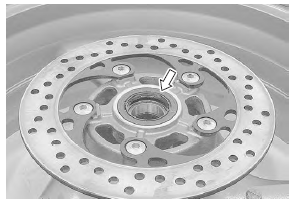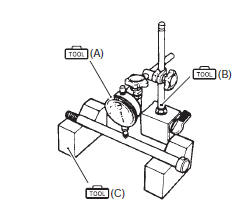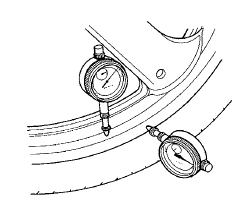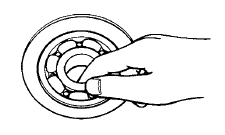Suzuki GSX-R 1000 Service Manual: Rear wheel related parts inspection
Refer to “rear wheel assembly removal and installation” .
Tire
Refer to “tire inspection” in section 0b .
Rear brake disc
Refer to “rear brake disc inspection” in section 4c .
Wheel damper
Refer to “drive chain related parts inspection” in section 3a .
Sprocket
Refer to “drive chain related components” in section 3a .
Dust seal
Inspect the dust seal lip for wear or damage. If any defects is found, replace the dust seal with a new one.
Refer to “rear wheel dust seal / bearing removal and installation” .

Wheel axle
Using a dial gauge, check the wheel axle for runout, if the runout exceeds the limit, replace the axle shaft.
Wheel axle runout service limit: 0.25 Mm (0.010 In)
Special tool
 (a): 09900–20607 (dial gauge)
(a): 09900–20607 (dial gauge)
 (b): 09900–20701 (dial gauge
(b): 09900–20701 (dial gauge
chuck)
 (c): 09900–21304 (v blocks)
(c): 09900–21304 (v blocks)

Wheel
- Remove the rear brake pads. Refer to “rear brake pad replacement” in section 4c .
- Make sure that the wheel runout checked as shown in the figure does not exceed the service limit. An excessive runout is usually due to worn or loosened wheel bearings and can be reduced by replacing the bearings. If bearing replacement fails to reduce the runout, replace the wheel.
Wheel rim runout service limit (axial and radial): 2.0 Mm (0.08 In)

- Install the rear brake pads. Refer to “rear brake pad replacement” in section 4c .
Bearing
Inspect the play of the wheel bearings by hand while they are in the wheel. Rotate the inner race by hand to inspect for abnormal noise and smooth rotation. Replace the bearing if there is anything unusual. Refer to “rear wheel dust seal / bearing removal and installation” .

 Rear wheel assembly removal and installation
Rear wheel assembly removal and installation
Removal
Loosen the axle nut (1).
Raise the rear wheel off the ground and support the
motorcycle with a jack or wooden block.
Caution
make sure that the motorcycle is support ...
 Rear wheel dust seal / bearing removal and installation
Rear wheel dust seal / bearing removal and installation
Removal
Remove the rear wheel assembly. Refer to “rear wheel assembly removal
and installation” .
Remove the rear sprocket mounting drum assembly
(1) from the rear wheel.
Re ...
Other materials:
Oil cooler / oil cooler hose removal and
installation
Refer to “electrical components location” in section 0a .
Removal
Turn the ignition switch off.
Remove the left side cowling. Refer to “exterior parts removal and
installation” in section 9d .
Drain engine oil. Refer to “engine oil and filter replacement” in
section 0b .
...
Engine bottom side assembly
Assemble the engine bottom side in the reverse order of
disassembly. Pay attention to the following points:
Note
apply engine oil to each running and sliding
part before reassembling.
Breather oil return plate
When installing the breather oil return plate (1), apply
thread loc ...
Exhaust control system description
The exhaust control system (excs) consists of the exhaust control valve (excv),
exhaust control valve actuator
(excva) and exhaust control valve cables (excv cables).
Excv is installed in the exhaust pipe. Excva is mounted inside of the right
frame. The excv is operated by the
excva via the ...
